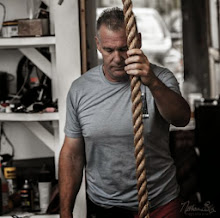I rented a documentary on Seabiscuit that was a compilation of "lost" newsreel footage about him.
What was really impressive is how small he was relative to the horses that he raced against, 15hh, how much lumbar coiling he was able to achieve and how fluid his body was. The lumbar coiling is the transfer mechanism for energy to the ground to allow the Center of Mass to be propelled forward. Through the coiling the spring mechanism of the lumbar aponeurosis is engaged as is the lattismus dorsi muscle/fascia. The greater the coil the more time the rear feet are on the ground and therefore the greater the energy exchange that occurs.
Increased lumbar coiling is one of the things that I look for in a horse that I am working with as a sign that the work is progressing well.
Another small horse with phenomenal lumbar coiling is the Australian racing legend Phar Lap.
If you go to youtube and watch the match race, here's the link, http://www.youtube.com/watch?v=RcnawQ7DFaE pay attention to how the two horses move their rear at the walk, around 51 seconds into the video. You can see that Seabiscuit is much more "reachy" with his rear legs a sign of a topline that can lengthen. You can also see, for people who've trained with me, the "wave" of energy from the GRF moving along the spine and out the head.
Phar Lap on the other hand was not as subtle along the top line and got his length through turning his neck upside down, or ewe neck, which positioned the poll closer to the rear feet.
enjoy
Monday, September 29, 2008
Subscribe to:
Post Comments (Atom)




2 comments:
Hi Jim,
I must admit i am intrigued with your technical reasoning as to why seabiscuit was so impressive, i have found this a really informative article and must try to watch the film as well. I have just started horse riding and it is through reading things like this that really draws me to these wonderful animals.
Jim, nice analysis.
One correction, however: Phar Lap stood a very tall 17hh. You can read more about him here at the National Museum of Australia's web site:
http://www.nma.gov.au/collections/collection_highlights/australian_society_and_history_since_1788/pharlaps_heart/
Keep up the great commentary!
Post a Comment